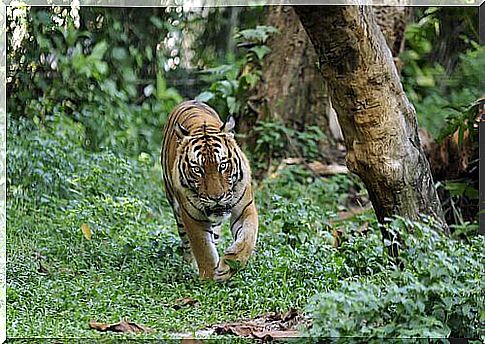5 Subspecies Of Tigers That Will Conquer You

Within the feline family, the Panthera tigris genus is found only in Asia. Together with the lion, they are the largest carnivorous predators in the world and, in total, five subspecies of tigers still exist today .
Even if they are very similar to each other, each one maintains particular characteristics that make them very interesting. So: would you like to discover with us the most beautiful and fascinating subspecies of tigers ? So, don’t miss this article.
What are the most beautiful tiger subspecies?
At first glance, they may look virtually identical, based only on their fur and predominantly carnivorous eating habits. But each of these five subspecies of tigers, as we shall see, differs in more than one element. To these, we should also add a sixth, the Amoy Tiger or Tiger of Southern China, but it has practically become extinct in the wild.
1. Sumatran tiger
With a wild population of 500, the Sumatran tiger – pictured that opens this article – is currently critically endangered. It lives only on this island of Indonesia, both in the forests and in the plains and also in the mountains.
It is the smallest of the currently living tigers. Males measure just over two meters and weigh around 120 pounds. The body stripes are thinner and have a well developed mane. In turn, they have a membrane between their toes, which they need to swim better.
2. Malayan tiger
This is another critically endangered tiger subspecies (about 500 copies remain in the wild). This second specimen lives in some areas of the Malay peninsula belonging to Thailand and also to Malaysia.

The male of the Malayan Tiger can reach 260 centimeters in length while the female is slightly smaller (it stops at 240 centimeters). They feed on deer, wild boar and wild pigs, although in some cases they can even hunt bear cubs, elephants and rhinos.
3. Indochinese tiger
Also called the Corbett Tiger, it lives in Cambodia, Laos, China, Moluccas (where it coexists with the Malayan Tiger), Burma, Vietnam and Thailand. Her wild population is around 1,300, so she too is in danger.

Males weigh just under 200 pounds and the fur is slightly darker than other tiger subspecies. It is a solitary animal, which feeds on large ungulates such as Indian sambar, deer, wild boar and local cattle in Indochina.
4. Bengal Tiger
We could say that the Royal Bengal Tiger is the best known and also the most widespread subspecies in Asia. It lives in India, Bangladesh (in these two countries it is considered a national animal), Tibet, Nepal, Bhutan and Burma. However, like the others, it is in danger of extinction.

The Bengal tiger’s fur is orange or brown and, due to a genetic mutation, it can also be white with black stripes. It is one of the largest exponents of the species, since the males exceed three meters in length and can weigh 200 kilos.
They live alone and protect their pups until they can fend for themselves. Most of the young are given birth between February and May, after a gestation of about 100 days. Each litter can consist of up to six cubs that are born with their eyes closed and that will remain with their mother for two years.
5. Siberian tiger
The last of the tiger subspecies receives several names: Amur tiger, Caspian tiger or Persian tiger. It lives in the forests in the southeastern tip of Russia, on the border with China and in the region crossed by the Amur River.

The Siberian Tiger is very present in the traditional culture of the region. It appears on the shields of various cities (such as Vladivostok and Irkutsk) and even a regional football team uses it as an emblem. It was the animal chosen as the symbol of the Seoul Olympic Games, celebrated in the now distant 1988.









